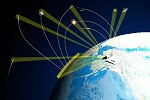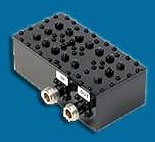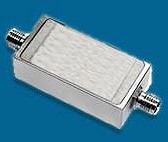Anatech Electronics Newsletter - April 2018 |

Press Release Archives: 2024 | 2023 | 2022 | 2021 |2020 2019 | 2018 | 2017 | 2016 | 2015 2014 | 2013 | 2012 | 2011 | 2010 2009 | 2008 | 2007 | 2006 | 2005 Content is copyright of company represented. Page format, custom text and images are RF Cafe copyright - do not distribute. 
Anatech Electronics, a manufacturer of RF and microwave filters, has published its April newsletter. In it, Sam Benzacar digresses from his usual insight into military and commercial telecommunications topics to address the potential for election fraud. It is not a politically charged treatise, but a commentary on the vulnerability of cybersecurity efforts - basically concluding that other than with old fashion paper ballots, meddlers have ample opportunity to rig the system without ever physically showing up at polling sites. Of course we know from history that even paper ballot results can be impacted by creative methods; e.g., ballot stuffing, intimidation, destruction of ballots, vote buying, deliberate miscounting, etc. Sam also includes some relevant telecomm industry headline news. A Word from Sam Benzacar  Hacking Elections: A Vote or Low Tech By Sam Benzacar Voter fraud and Russian hacking being some of the biggest news stories in the last few years, I decided to learn a bit about just how big a problem this is or could be. In the end, I concluded, that because America's voting systems range from archaic to sophisticated, the country is actually more secure for its chaos and lack of technical sophistication at the voting booth. To see why this is the case, consider the following. There are basically six ways to post a ballot in America:
My first impression after learning this was why the entire country cannot simply have one standardized voting method. While this makes sense in theory, in practice it's incredibly difficult, as competition and the "right of choice" complicate things. In fact, the government has been working for more than two decades to solve this problem, so far unsuccessfully. It might not be such a terrific idea anyway. If only a single system was used throughout the country a hacker would potentially need only one point of entry, although various means could mitigate this. In addition, with so many different systems, it becomes increasingly difficult and perhaps almost impossible to alter the votes of every state. And the least sophisticated of these, paper ballots, are the least hackable of all. From the perspective of cybersecurity at least, the most secure systems are the least sophisticated and "disconnected" (air gapped). Perhaps there's a message here about cybersecurity in general: When data enters a wired or wireless domain for transfer from one place to another it can be breached. As a result, sometimes low tech is better, especially when facing a wily adversary and where successful hacking results in much more than lost credit card information, as it certainly is with American elections.
What's News... Chinese Radar Can Detect Bugs… and Stealth Fighters
Space Debris: Falling Like Rain
Long-Range Missile Defense Radar Moves Forward
AT&T Gets OK to Deploy FirstNet
Check out Our Filter Products
Cavity Band Pass Filters LC Band Pass Filters Cavity Bandstop/Notch Filter About Anatech Electronics Anatech Electronics, Inc. (AEI) specializes in the design and manufacture of standard and custom RF and microwave filters and other passive components and subsystems employed in commercial, industrial, and aerospace and applications. Products are available from an operating frequency range of 10 kHz to 30 GHz and include cavity, ceramic, crystal, LC, and surface acoustic wave (SAW), as well as power combiners/dividers, duplexers and diplexers, directional couplers, terminations, attenuators, circulators, EMI filters, and lightning arrestors. The company's custom products and capabilities are available at www.anatechelectronics.com. Contact: Anatech Electronics, Inc. 70 Outwater Lane Garfield, NJ 07026 (973) 772-4242
Posted April 11, 2018 |
 The
Chinese military has reportedly reached a "significant milestone" in its development
of new radar capable of detecting stealth airplanes. Chinese scientists have developed
new military radar technology that could detect stealth bombers and fighters in areas
of the Pacific Ocean beyond Chinese borders. The device can track mosquito-size targets,
and in fact is being used for just that. As infectious diseases transmitted by mosquitoes
cause more than 1 million deaths per year, the radar when made portable as has high enough
resolution to track swarms of the insects so that they can be eradicated on a local basis.
The radar can detect the wing-flapping of a mosquito up to 1.2 miles away, according
to a senior scientist involved in the government research project.
The
Chinese military has reportedly reached a "significant milestone" in its development
of new radar capable of detecting stealth airplanes. Chinese scientists have developed
new military radar technology that could detect stealth bombers and fighters in areas
of the Pacific Ocean beyond Chinese borders. The device can track mosquito-size targets,
and in fact is being used for just that. As infectious diseases transmitted by mosquitoes
cause more than 1 million deaths per year, the radar when made portable as has high enough
resolution to track swarms of the insects so that they can be eradicated on a local basis.
The radar can detect the wing-flapping of a mosquito up to 1.2 miles away, according
to a senior scientist involved in the government research project.  As the media focused on the impending crash of China's
Tiangong-1 space station, on average, about 100 tons of space junk burns up in Earth's
atmosphere every year, averaging one complete spacecraft per week. The falling debris
ranges from dead satellites to uncontrolled spacecraft, the upper stages of rockets,
and assorted other pieces of space borne material. In most cases, this debris falls into
the ocean or lands somewhere far away from human settlement.
As the media focused on the impending crash of China's
Tiangong-1 space station, on average, about 100 tons of space junk burns up in Earth's
atmosphere every year, averaging one complete spacecraft per week. The falling debris
ranges from dead satellites to uncontrolled spacecraft, the upper stages of rockets,
and assorted other pieces of space borne material. In most cases, this debris falls into
the ocean or lands somewhere far away from human settlement.  Lockheed Martin has received an additional $8.4 million
for its Long-Range Discrimination Radar (LRDR) program that is the core of the Missile
Defense Agency's strategy for protecting the U.S. from ballistic missile attacks. LRDR
is an S-band common ground-based AESA radar that uses GaN-based T/R modules from the
company's Open GaN Foundry model. It provides continuous coverage even when undergoing
maintenance and is expected to enhance missile defense by improving the ability to distinguish
missiles from debris and decoys.
Lockheed Martin has received an additional $8.4 million
for its Long-Range Discrimination Radar (LRDR) program that is the core of the Missile
Defense Agency's strategy for protecting the U.S. from ballistic missile attacks. LRDR
is an S-band common ground-based AESA radar that uses GaN-based T/R modules from the
company's Open GaN Foundry model. It provides continuous coverage even when undergoing
maintenance and is expected to enhance missile defense by improving the ability to distinguish
missiles from debris and decoys.  The First Responder Network
Authority (FirstNet) recently gave AT&T formal approval to begin building the nationwide
public safety broadband network. Every state has now opted into the network to be built
by AT&T rather than opting out and going it alone. The company recently restated
his commitment to reaching 95% of the U.S. population in five years. Once that is achieved,
it will mark the first time the country has had a nationwide, interoperable network for
first responders.
The First Responder Network
Authority (FirstNet) recently gave AT&T formal approval to begin building the nationwide
public safety broadband network. Every state has now opted into the network to be built
by AT&T rather than opting out and going it alone. The company recently restated
his commitment to reaching 95% of the U.S. population in five years. Once that is achieved,
it will mark the first time the country has had a nationwide, interoperable network for
first responders. 

